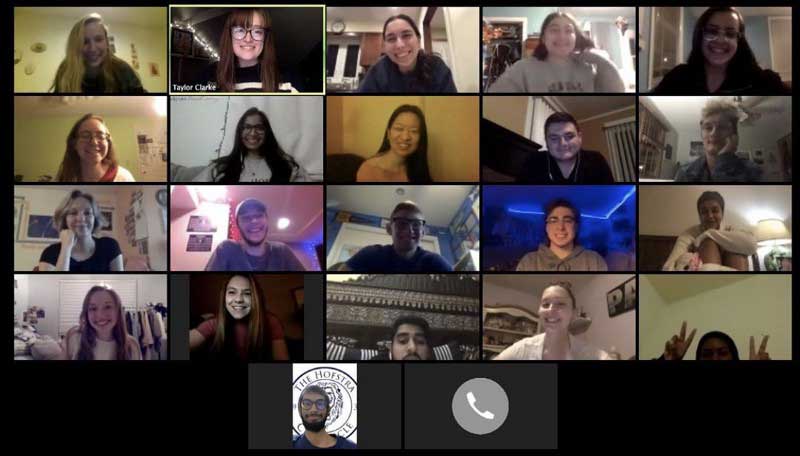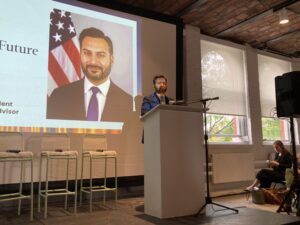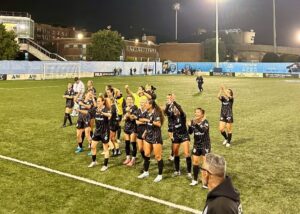By Visvajit Sriramrajan
Hofstra University’s shutdown in March because of the Covid-19 pandemic brought up questions about the university’s plans to proceed with the rest of the semester. The shift to digital learning was met with mixed reactions by students across a variety of majors, faculty from different departments, and administrators working with students and staff.
Despite the challenges, as one professor reported, “lots” of learning still did take place this semester.
The Hofstra University campus cleared out of students and faculty in March when the Covid-19 pandemic struck in New York, but teaching and learning continued online. Courtesy Hofstra University
Teleconferencing services like Zoom have enabled members of the Hofstra community to continue meetings as originally planned, but fears about potential security lapses, instructional difficulties, scattered attendance and participation, time zone navigation and excess screen time have proven to be troublesome, faculty and students reported.
And while a number of professors have embraced the challenges by experimenting with new digital tools and altering course curricula, others whose classes were traditionally more hands-on have struggled.
Zoom has been crucial in connecting the university, whose students come from places as close to campus as Garden City and as far away as Mumbai, India. Although transitioning to the platform has required effort by professors and students, it has allowed classes to continue.
Professors have opted for synchronous classes, which are conducted live over services like Zoom, or asynchronous classes, which involve a combination of pre-recorded videos, discussion board posts on Blackboard and assigned textbook work.
“My students have been incredibly patient with me during this time,” noted Dr. Christa Farmer, a geology professor who holds synchronous classes for her upper-level students and asynchronous classes for her introductory classes.
“While it hasn’t been without missteps, the process has worked pretty well in general,” Farmer said. “I still believe strongly that my students have learned lots this semester, despite the immense challenges of working and learning through a global pandemic.”
A number of students said they struggled to work from home. “I’ve definitely always been a homebody, so when I found out that classes would be online for the remainder of the semester, I honestly didn’t think much of it,” said Drashti Mehta, a junior journalism major. “But I also wasn’t considering that I was making the place I associate with relaxation a place of work and study too, and I think that’s affected me a lot.”
Mehta said she has strived to keep up with her work and remain productive, despite the difficulty of carving out a work-oriented headspace in her New York City home. Besides her academic responsibilities, she works as an undergraduate assistant for the Lawrence Herbert School of Communication, serves as the features editor for The Hofstra Chronicle and is an aide for the university’s physician assistant program. These commitments have translated into frequent meetings with administrators via Zoom.
“The additional screen time has been doing a number on my migraines, which have been constant since the shift to Zoom,” she said. Nevertheless, Mehta has been able to adjust to the new circumstances and persevere through her work.
At the same time, self-motivation has been an obstacle for students more reliant on syllabi and structured learning. “Nearly everyone I talk to, myself included, is simply forcing ourselves to open our books and learn the material,” said Talha Siddiqui, a junior biology major. “Not all our professors use Zoom and instead have pre-recorded lectures.”
Siddiqui acknowledged that asynchronous instruction has allowed students to refer back to notes and other materials throughout the semester, and that it benefits students spanning several time zones who are unable to attend classes during regularly scheduled times.
He said, however, that the lack of live interaction between professors and students has meant the onus of learning is placed on the student. “It isn’t fair that tuition rates have remained stagnant while the quality of education students are receiving has decreased significantly,” he said.
While students like Siddiqui dislike pre-recorded lectures, certain professors have justified their use. Marlon Hurt, an adjunct professor of linguistics, opted to switch to an asynchronous structure, uploading lessons to Blackboard. “In fact, connectivity and reliability were my two big considerations in deciding against using Zoom,” he said. “It’s nothing particularly against Zoom, though — the connectivity especially is an issue with my own Internet provider, and I wouldn’t depend on Hofstra to pay for an upgrade to my service.”
Although Hofstra lists cellular data plan options and other companies offering limited access to students, the university has not assisted in sponsoring Internet services for students, faculty and administrators who need it. Hurt also cited the recent “Zoombombing” phenomenon in which unwanted individuals enter Zoom calls through links made publicly available and disrupt instruction or discussion. This is one of several technological bugs and loopholes that have been found in Zoom’s software.
Though Zoom 5.0, the application’s latest firmware update, is supposed to have fixed these issues, professors like Hurt remain skeptical. Nonetheless, the software’s popularity and mass licensing packages for educational institutions have deemed it a go-to application for not only faculty and students, but also administrators, many of whom were unfamiliar with digital teleconferencing tools before the pandemic.
“Folks who are older have had a tougher time adjusting and have noted a lot of anxiety and stress around trying to navigate Zoom,” said Denise Boneta, the associate director for student leadership and engagement. Boneta noted that some of Zoom’s ancillary features, such as the use of emoticons, virtual hand raising and breakout rooms, have been difficult to teach to others, but have allowed her to make the most of digital communication.
“It’s been hard to watch them struggle and not be able to physically be with them to talk through steps, but I have found myself lending out a helping hand by walking some of my colleagues through the platform over the phone,” she said.
Student leaders, however, have had relatively little trouble with the technical aspects of Zoom. Though the software does have its flaws, it has allowed the Student Government Association to operate as usual with weekly Senate meetings. The Hofstra Chronicle, another student organization that Boneta advises, has also hosted story meetings weekly and held an election. “If you’re not afraid to engage, you can run organized and efficient meetings,” Boneta said.

Professors from departments like biology and chemistry have struggled to transition laboratory work online. Some have resorted to YouTube videos and other online content, but they cannot replace hands-on learning.
Dr. Beverly Clendening, an associate biology professor, taught all laboratory classes this semester on subjects like cell biology, genetics and neurobiology. “The Zoom engagement is not the same as science lecture classes,” Clendening said. Though she can encourage students to take part and remain active and attentive, she said there is only so much she can do given the absence of face-to-face dialogue.
Meanwhile, biology professors like Dr. Russell Burke have been able to find a sweet spot between teleconferencing and individual check-ins. Burke noted that he and his students were fortunate that coursework was project-based, could be done mostly independently, and feedback could be given online.
“This allows us to do pretty much all the normal things. Plus, I really like getting feedback from my students on how they are doing personally,” he expressed. “It’s important to me to be aware of how my students are doing in these challenging conditions.”










